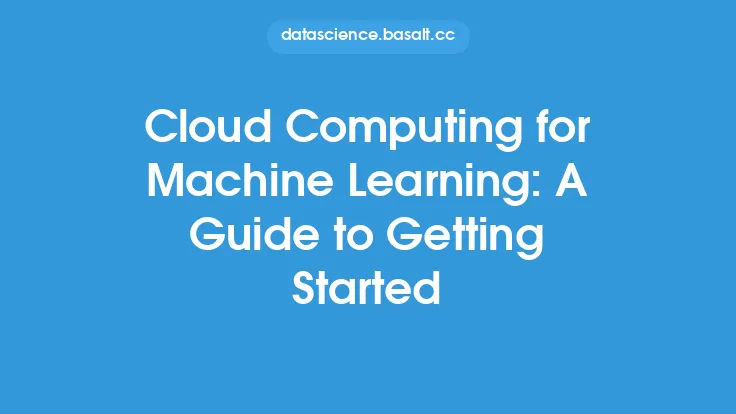Getting started with data management can seem like a daunting task, especially for those who are new to the field. With the exponential growth of data in recent years, it's become increasingly important for organizations to have a solid data management strategy in place. In this article, we'll take a closer look at the fundamentals of data management, including what it entails, its importance, and the key concepts and techniques involved.
Introduction to Data Management
Data management refers to the process of collecting, storing, organizing, and maintaining data in a way that makes it accessible, reliable, and secure. It involves a range of activities, from data ingestion and processing to data storage and retrieval, and is critical for ensuring that data is accurate, complete, and consistent. Effective data management is essential for organizations to make informed decisions, improve operational efficiency, and reduce costs. It's also crucial for ensuring compliance with regulatory requirements and industry standards.
Key Concepts in Data Management
There are several key concepts that are essential to understanding data management. These include:
- Data governance: This refers to the overall management of an organization's data assets, including the development of policies, procedures, and standards for data management.
- Data quality: This refers to the accuracy, completeness, and consistency of data, and is critical for ensuring that data is reliable and trustworthy.
- Data security: This refers to the protection of data from unauthorized access, use, or disclosure, and is essential for ensuring the confidentiality, integrity, and availability of data.
- Data storage: This refers to the physical or virtual infrastructure used to store data, and can include databases, data warehouses, and cloud storage solutions.
- Data processing: This refers to the manipulation and transformation of data into a format that is suitable for analysis or other uses.
Data Management Techniques
There are several data management techniques that are commonly used in organizations. These include:
- Data normalization: This involves organizing data into a standardized format to reduce data redundancy and improve data integrity.
- Data denormalization: This involves storing data in a format that is optimized for query performance, rather than data integrity.
- Data warehousing: This involves storing data in a centralized repository that is optimized for analysis and reporting.
- Data mining: This involves using statistical and mathematical techniques to extract insights and patterns from large datasets.
- Data visualization: This involves using graphical and visual techniques to communicate data insights and trends.
Data Management Tools and Technologies
There are many data management tools and technologies available, each with its own strengths and weaknesses. These include:
- Relational databases: These are traditional databases that use a fixed schema to store data, and are well-suited for transactional data.
- NoSQL databases: These are non-relational databases that use a flexible schema to store data, and are well-suited for big data and real-time web applications.
- Cloud storage solutions: These are scalable and on-demand storage solutions that are well-suited for storing large amounts of unstructured data.
- Data integration tools: These are used to integrate data from multiple sources, and can include extract, transform, and load (ETL) tools and enterprise service buses (ESBs).
- Data analytics platforms: These are used to analyze and visualize data, and can include business intelligence (BI) tools, data science platforms, and machine learning frameworks.
Best Practices for Data Management
There are several best practices that organizations can follow to ensure effective data management. These include:
- Developing a data management strategy: This involves defining the organization's data management goals, objectives, and policies, and is essential for ensuring that data management is aligned with business objectives.
- Establishing data governance: This involves defining the roles, responsibilities, and processes for managing data, and is critical for ensuring that data is accurate, complete, and consistent.
- Implementing data quality controls: This involves using techniques such as data validation, data cleansing, and data normalization to ensure that data is reliable and trustworthy.
- Providing data security: This involves using techniques such as encryption, access controls, and backups to ensure the confidentiality, integrity, and availability of data.
- Monitoring and evaluating data management: This involves using metrics and key performance indicators (KPIs) to evaluate the effectiveness of data management, and is essential for identifying areas for improvement.
Common Data Management Challenges
There are several common data management challenges that organizations face. These include:
- Data silos: These occur when data is stored in separate systems or departments, and can make it difficult to integrate and analyze data.
- Data quality issues: These can include data errors, inconsistencies, and incompleteness, and can make it difficult to trust and rely on data.
- Data security threats: These can include cyber attacks, data breaches, and unauthorized access, and can compromise the confidentiality, integrity, and availability of data.
- Data scalability: This refers to the ability of data management systems to handle increasing amounts of data, and can be a challenge for organizations that are experiencing rapid growth.
- Data complexity: This refers to the complexity of data management systems, and can make it difficult to manage and maintain data.
Conclusion
Data management is a critical component of any organization's data strategy, and is essential for ensuring that data is accurate, complete, and consistent. By understanding the key concepts, techniques, and best practices involved in data management, organizations can develop a solid data management strategy that aligns with their business objectives. Whether you're just getting started with data management or are looking to improve your existing data management practices, this article has provided a comprehensive overview of the fundamentals of data management, and has highlighted the importance of effective data management in today's data-driven world.




